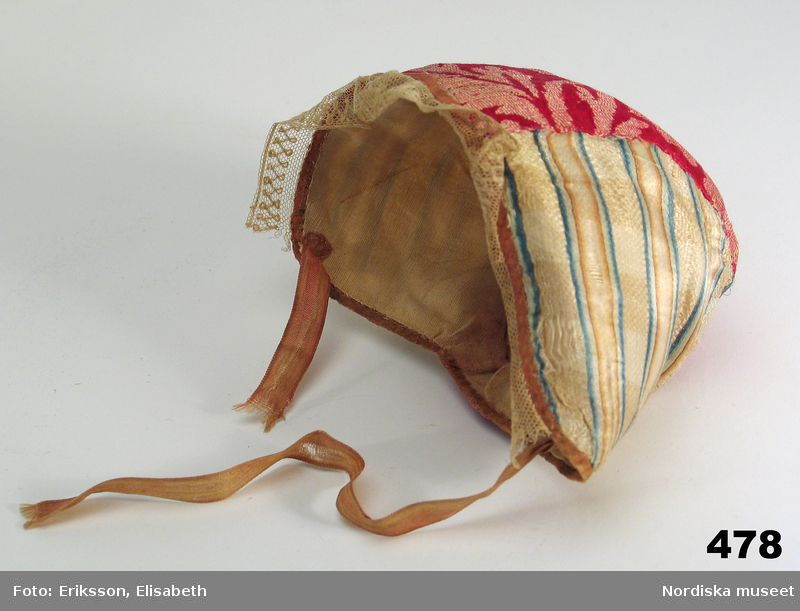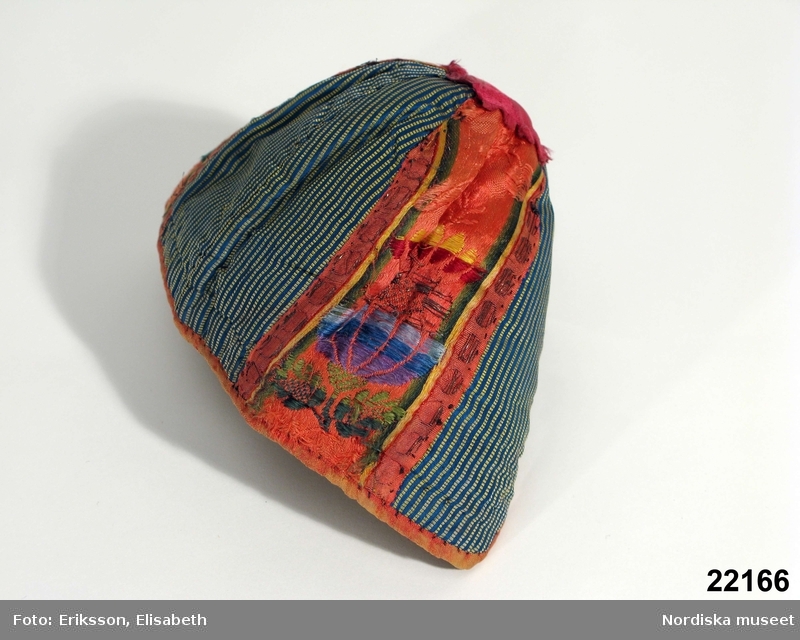These three dress elements were used by both boys and
girls, but the construction was different. Girls koltar had a gathered skirt sewn to a bodice, a cap constructed
from one piece reaching from forehead to nape of neck, and two sidepieces, and
an apron tied at the waist, like their mothers'. Boys koltar
on the other hand were cut in one from the shoulders, their caps were
constructed from 4-6 gussets, and their aprons had bibs. To most people today
they’d all look like little girls, but a person of that time and place could
tell one from the other at a glance.
Girl's silk Christening cap, made from one
middle piece, and two side pieces, c. 1810-1830.
Boy's silk Christening cap, made from five gussets, c. 1810-1830.
It matches the girl's cap above - where they made before baby was born, or for twins?
Boy's silk Christening cap, made from six gussets, c. 1800-1840.
Not much is
known about everyday clothing of these children – the few surviving garments
are all for festive occasions, and most are from the county Dalarna (Dalecarlia), as the people there kept their traditional way of dress longer than most others in Sweden. This means you have to think one extra time - is this typical of children in Sweden, or typical of children of Dalarna? Most extant caps are christening caps, and as
such, are made from the most expensive materials the families could afford. I,
who wanted a simpler outfit for my little lad, had to guess what to use.
For the cap
I used cotton scraps I had in my stash. Seeing more than one fabric in these
caps is very common, so I decided to do that. One is a sort of plaid, the other
striped (scraps from making a baby wrap, that have seen much use, first with my
youngest brother, and then with little B), the lining is a striped, much worn
kitchen towel. I decided to put a stitched down tuck over each ear, for better
fitting: I don’t know if it’s period, but it looks all right. The cap is bound
with cotton tape from my stash, and the ties are made from the same.
The apron
is made from an old pillowcase with woven in stripes (as stripes were so
typical in aprons among the commoners here in the 19th century) that I bought at a
charity shop. The ribbon used for ties is woven for the purpose – I had the
yarn at home.
I have a
loom for weaving ribbons, but it’s in storage, and how I miss it! For making
the ribbon I had to figure out something else. I decided to make a rigid
heddle. I want a real wooden one, but that’s not a priority at this time, so I
had to make do with an improvised one, made from a milk carton and a couple of
pencils.
It worked tolerably well, except that the pencils kept escaping. Now
that I’ve used one (poorly constructed though it was) I really want a real one!
It was such a pleasure to work with.
The skirt
part of the apron is pleated to the waistband, and the bib sewn in flat. A loop
around the neck holds it in place, just like in originals.
The
Challenge: #6 Stripes
Pattern: None,
draped my own.
Year: About
mid 19th century. If made from wool, they could be earlier.
Notions: Waxed
linen thread, cotton/linen yarn for weaving, cotton tape.
How historically
accurate is it? Tolerably, though I had to guess a whole lot.
At least it’s hand sewn with period stitches.
Hours to complete: Good
question…maybe 10 hours total, including the weaving.
First worn: The
apron has been worn several times when B has been helping me baking, the cap
was first worn for the pictures.
Total cost: 10 SEK ($1,5, £1, €1,2) for the
apron fabric, the rest was scraps from my stash, including the cotton tape.
And all
that work just so that I can have a companion when being photographed in my
common women’s dress for challenge 10....











Vad fint det blev! Kreativ lösning med bandgrinden också, det funkade ju uppebnarligen.
ReplyDeleteOh my goodness, he is adorable in his new little outfit! That cap is wonderful! I have never heard of weaving ribbons and you just amazed me! That is truly incredible and what a wonderful art and talent you have! WOW!!
ReplyDeleteI love the attention you give to the details in your work! That woven waistband on his apron is a work of art in itself.
ReplyDeleteBy the way, I have nominated you for the Very Inspiring Blogger Award!
http://threadheaded.blogspot.com/2013/03/id-like-to-thank-academy.html